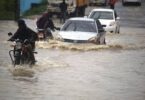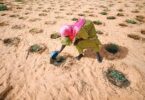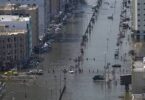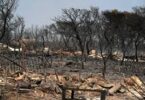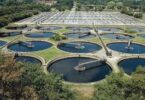ARCHERS POST, Kenya (AP): Letoyie Leroshi walked for five days hunting water. After three years of drought in Samburu County, Kenya, the riverbeds were bone-dry.
Then Leroshi found a patch of wettish sand in the sunbaked Ewaso Ng’iro riverbed. He brought a group of fellow herders to dig. They hit water and the jubilant young men broke into song, a traditional call to their cattle and camels.
Harnessing Eastern Africa’s groundwater could be a huge benefit for a region struggling to slake its thirst. Climate change is making drought more likely but, as in much of the continent, people in East Africa and the Horn of Africa lack the resources to tap groundwater on a wide and efficient scale.
For Leroshi and other Kenyan herders, the situation is desperate.
Samburu women fetch water in Loolkuniyani Primary School, Samburu county, Kenya on Sunday, Oct. 16, 2022. Experts urge thoughtful use of this resource to ease water shortages. The United Nations water agency estimates that roughly 400 million people across Africa lack access to clean water. (AP Photo)
“We had thousands of livestock four years ago when we experienced short rains,” he said. “We have lost hundreds of our cattle and are now worried that if the rains fail yet again, we will lose everything.”
Leroshi and other herdsmen carry weapons and are prepared to fight if attacked by people trying to steal from them.
“Everyone else around is also armed and ready to steal our livestock,” he said.
The British charity WaterAid and the British Geological Survey found that Africa has enough groundwater for most countries to get through at least five years of drought.
“Groundwater has great potential for drought resilience,” said Girma Ebrahim, a hydrogeologist with the International Water Management Institute.
The United Nations water agency estimates that roughly 400 million people across Africa lack access to clean water.
Lmeshen Lekoomet, 54, recently left with the family’s few remaining animals in search of pasture and water.
As his family waited, his 2-year-old became severely dehydrated and malnourished and was hospitalized. Lekoomet never returned.
In the coastal cities of Dar es Salaam in Tanzania in 1997, and in Cape Town in South Africa in 2017, drought led people to use groundwater.
In Ethiopia, wells equipped with handpumps outperformed all other sources during a drought in 2015 and 2016.
Samburu women sing under a tree as they make a daily pilgrimage to a reservoir where they spill milk on the parched landscape as an offering on Thursday, Oct. 13, 2022, in Samburu County, Kenya. They perform this ceremony every day until rain comes. (AP Photo)
Africa has 72 giant aquifers that are largely untapped, scientists say. Some farming and pastoral communities in these regions already rely on wells, using digging by hand and with solar-powered equipment.
“This is a game-changer,” said Edwin Macharia, the director of programs for the aid agency Mercy Corps in Ethiopia.
Other regions of the world provide cautionary tales of how the misuse of groundwater can make situations worse.
“Not to say it should not be exploited,” said Philip Wandera, former director of the Kenya Wildlife Service and now range-management lecturer at the Catholic University of Eastern Africa. But, he said, “Groundwater is not a quick-fix answer for the current drought … if you have been poor managers of surface water, it means you are likely to do the same with groundwater.”
Only 3% of the total cultivated land in sub-Saharan Africa is irrigated land, according to the U.N. Only 5% of that land is irrigated with groundwater.
Groundwater exploration and construction are impossible without financing. Many countries outside Africa had enough money to create groundwater databases and hydrogeological maps in the 1980s.
“Smallholder farmers who make up most food producers on the continent,” badly need irrigation technology, said Agnes Kalibata, who heads the Alliance for a Green Revolution in Africa.
The U.N. says that, despite concerns about groundwater, the continent’s resources are largely unaffected by climate change.
“Millions of people don’t have enough safe, clean water to meet their daily needs, let alone face the climate crisis,” said Tim Wainwright the chief executive of WaterAid in the United Kingdom. “Governments, along with the private sector, should use COP27 to agree on investments in responsible groundwater use, along with clear management guidelines to harness it.”
Those in Samburu can’t wait much longer, with many herders on the brink of losing everything.
“I have lost 30 cows in a span of two weeks and if it continues like this we will lose many more. Our women and children are also severely affected,” said 30-year-old herder Lemerwas Limayo. “Drought ravages all living things.”

